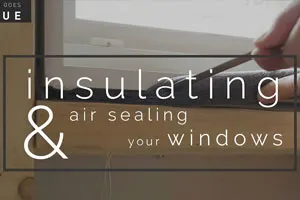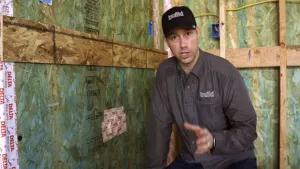In this video, Matt Risinger, master builder, discusses the installation of a Marvin Integrity window multiple ways, with Huber Zip, Henry Blueskin VP100 Peel & Stick and also how to retrofit a window in a tar paper flashed wall with Prosoco Fast Flash. According to Risinger, Marvin's Integrity brand is more affordable but a fantastic fiberglass window with a wood cloud interior. Beginning with a zip wall found at new construction or additions, it's an OSB sheathing with a green face runner this is a waterproof and airtight Membrane. Risinger likes the system since once it is installed, all that's left is detailing the seams and installing the windows. The house is watertight and very air tight as well. For the install, the plywood is cut flush around the rough opening and there is a slope sill a slope sill or you can add a shim underneath to pitch water forward. If a window does leak, it is typically in the corners where welds come together. No matter what, the rough opening must be waterproof. Zip manufactures a product that's a stretch tape that comes with a release backer. Measure the sill and add one foot to that so that the tape goes up approximately 6 inches on both sides. On the jobsite, use a speed square or a hard scraper to get it in the corners. Stretch the material on the outside and the acrylic adhesive will grab quickly. The green surface is the ideal surface for them. It doesn't move or peel back. If you are in a coastal environment or have a no overhang house, make sure that the exposed wood on the inside is also not going to get wet from coastal storms. If it was an old job, not new construction, there might be a half-inch gap that would need to be filled with spray foam. Then you'd use a different product that is pink and has a fibrous material it. But now, the first thing is to go down all the joints, starting in the corners and also the plywood joints. Add a zigzag snake pattern or do stripes. Spread caulking into the corners first to make sure that corner is protected and smooth it out. Then do the other sides.If this opening had tar paper, instead of the scraper you can use a bristle brush if using the scraper might rip and tear it. Typically tar paper would be cut at the window opening forming an apron, you would use this material to bond between the jamb the sheathing and the tar paper, then continue on to the flashing. Use fluid apply to wrap on top, which is a glue, so we're gluing it to the opening. This is a moisture-cure material. If it's dry it will take longer to cure but if it's wet or hot, it will cure faster. You can speed all that up by misting it. Remember, once it is on your clothes, it's not coming off. If you catch it before it cures, you can use a solvent to remove it. Finally, don't ever let anyone install a window without a sill pan. Remember that if nothing else.
Search Content
Use the search bar above, explore content using the categories below, or log in to find your favorites.
Create An Account
Thank you for choosing to create an account with us.
Please note that creating an account is optional, but helps us better tailor the content we show you.
Please enter your email address and choose a password.
Choose Areas of Interest
Please tell us a little more about your profession.
This is optional, but lets us better tailor content to your specific interests.
You can read our policy on data collection and privacy here.
Channels that Interest You
Finally, check which channels interest you so you can see more relevant content. Choose as many as you like. You can also come back here and edit these settings later.

 Share on facebook
Share on facebook Tweet
Tweet Email
Email Share on Linkedin
Share on Linkedin














